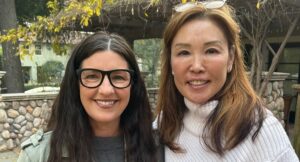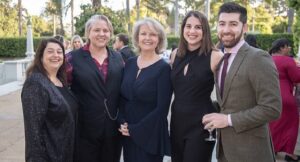
Sargent Claude Johnson, Head of a Boy, ca. 1928, glazed stoneware, 7 1/2 × 4 3/4 × 6 in. Photo courtesy The Huntington Library, Art Museum, and Botanical Gardens
On Saturday, a groundbreaking conference at The Huntington Library, Art Museum, and Botanical Gardens celebrates Black artists and activists’ artistic and cultural legacy in the Golden State.
The two-day event concludes today. It will present a deep dive into the profound impact of Black histories within the realms of visual and performing arts.
It’s paired with a rare opportunity to see the works of two of the most influential Black artists of the 20th century under one roof: Sargent Claude Johnson, a sculptor, painter, and ceramist who created expressive and stylized representations of Black figures and motifs; and Betye Saar, a multimedia artist who uses found objects, collage, and assemblage to create powerful and provocative statements on race, gender, and spirituality.
The conference, “Shaping Black Modernisms: Art, Culture, and Community in California,” brings together scholars, artists, and community members to examine Black modernists’ rich and diverse contributions to the state’s artistic and cultural landscape.
Held on Feb. 23 and 24 at The Huntington’s Rothenberg Hall, the conference features panels, lectures, performances, and workshops exploring topics such as Black radicalism, Black feminism, Black spirituality, Black aesthetics, and Black representation. The speakers include experts from the California African American Museum (CAAM), the University of Southern California (USC), and other institutions.
Dennis Carr, the Virginia Steele Scott Chief Curator of American Art at The Huntington, said the conference and the exhibitions are part of a larger effort to highlight the diversity and complexity of American art and culture. “We want to show that there is not one single narrative of American art, but many narratives that intersect and overlap,” he said. “Black modernisms are an integral part of that story, and we hope to illuminate their impact and relevance for today’s audiences.”
The conference is also a rare opportunity to connect with the artists and activists who shaped Black modernisms in California and beyond. Some of the highlights include a keynote address by Saar, a conversation with Johnson’s grandson, and a performance by the Lula Washington Dance Theatre, a renowned company that celebrates Black culture and history through dance.
The conference continues on Saturday, Feb. 24, with more sessions and activities that will delve deeper into the themes and issues raised by the speakers and the artworks. The attendees are looking forward to learning more, engaging in dialogue, and celebrating the achievements and innovations of Black modernisms in California and beyond.
“We’re absolutely delighted to have both of these shows on at The Huntington, which brings to the fore issues of black creativity in California during the 20th and 21st centuries,” Carr said. “The conference will have a variety of panels and performances that focus on black visual arts, but also music in the 20th century.”
With the conference and the exhibits, The Huntington aims to spotlight the profound artistic contributions of African Americans in California and beyond, exploring themes deeply rooted in Black culture and community.
Carr said both Johnson and Saar – one historic and one contemporary – have left indelible marks on the sculptural landscape, utilizing a diverse array of materials in their creations.
“Johnson himself participated in what we now think of as the Harlem Renaissance in New York. He showed his work in New York, he won awards, but his major artistic output was done among a community of artists in the Bay Area,” Carr said. “In the case of southern California, there was a community of black artists working in the mid-century, including Richmond Barthé, Charles White and Betye Saar of course, who grew up in Pasadena and Los Angeles.”
The conference’s lineup includes captivating talks by academics and artists, interspersed with mesmerizing performances of music by Black composers.
“We’ll also present a panel for musical performances by Pasadena City College students and faculty to perform the works of two black composers. William Grant Still and Harold Bruce Forsyth still created a suite for violin and piano that was based specifically on a work by Sergeant Johnson, ‘Mother and Child,’ that’s on view in the exhibition.The performers will present two works of music right out of the archives.”
Carr said he hopes the conference would bring a broader understanding and appreciation of Black modernism.
“We hope to draw attention to a time period when Black arts flourished throughout the state of California and really form the basis of a very vibrant art scene today throughout the state,” he said. “And we want to focus on underrepresented voices, understudied careers, and lesser known art forms.”
Tickets are $25 for general admission, and free for long-time fellows of The Huntington and students. To RSVP for the event on Friday and Saturday, visit https://huntington.org/black-modernisms.






